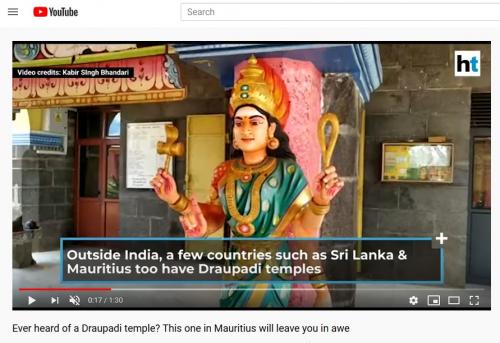
Behind the scenes; Diwali, festival of light
Foray into the preparations of Diwali, and experience behind the scenes of this very popular festival in Mauritius with Mymoris.
Behind the scenes; Diwali, festival of light
More than a century ago, about half a million Indians came to Mauritius to work in the sugarcane fields. They brought with them their culture, their Gods and the festival of light, Diwali which celebrates the triumph of good over evil.
In Mauritius on the night of Diwali, celebrants light clay lamps, placing them through their homes and share sweets with their families and neighbours.
To foray into the preparations, My moris experience behind the scenes of this very popular festival in Mauritius.
A temple, because it is a religious, Hindu festival
Sri Krishnamoorthy Draupathi Ammen Kovil, is a Tamil Temple from southern India. It is one of the first temples of Mauritius that date from 1860 and also one of the rare temple dedicated to Krishna in Mauritius.
Built with carved rocks, the Dravidian architecture of the Hindu temples follows a strict plan according to the principles dictated in the sacred works. The plan of the temple is a reflection of the cosmos, but also of the human body which is also its mirror. It faces east, the direction in which the sun rises. The tower represents the head, the shoulders on both sides, and the pole (koudimaram) represents the navel.
The workshop of Mr Salil, a potter who makes Diyas, terracotta lamps at Arsenal Village
Potters at Arsenal dates from the time of the construction of the Port Louis granary (1920s), built with red clay bricks and manufactured at Arsenal Village by Indian worker. After the construction of the granary they continued their activity at Arsenal.
Diya are made with a mixture of soil - which they recover in the neighborhood (clay soil is a specificity of the region) and rock sand dust (small rocks). They crush the mixture in a machine, sift, soak, and then knead it with the feet.
In the workshop they will mold the soil and give a shape using the potter's wheel. The precision, speed of execution and calibration of the workers are impressive.Then the pots are put to dry in a ventilated room before being baked.
The oven is made of cement bricks which retain heat (in the days of its ancestors, the oven was entirely made of red bricks). The pots are cook over low heat using wood. It takes about two days, and requires constant supervision.After removing from the oven, Salil check each pieces and If there are cracks, he try to cover them up with a brush.
A puja shop, which sells what is necessary for puja (prayer rituals)
It contains everything you need to do the daily puja (rituals) at home, in the temple, at weddings, etc. Also statues to install at home or in the courtyard to pray.We can find the terracotta oil lamps(diya) of Salil which are used in puja.
The puja shops across the island and also individuals buy Diyas directly from Salil workshop as Durga pujas and Divali approaches. Preparations for Divali begin several months earlier. Each year, they manufacture several thousand diyas which are sold at Rs 3 per unit.
Brinda's cakes
Brinda, a merchant of Dholl Puri, actively prepares the Potato cakes ‘Gateau patate’, only made on this particular occasion each year and that will be offered to friends and family. Origin of India, where it is not the most typical for this festival it small sweet potato shoe, stuffed with coconut and fragranced with cardamom.






